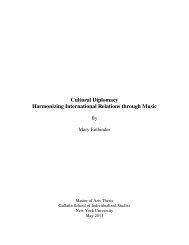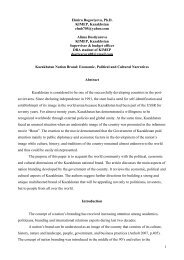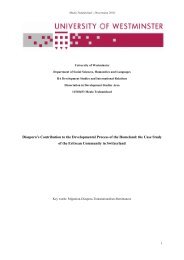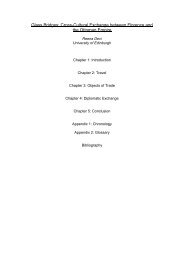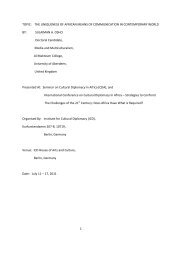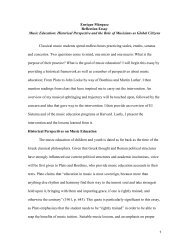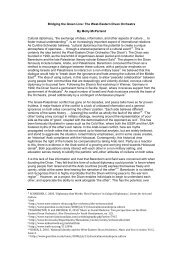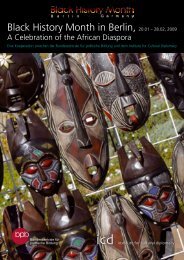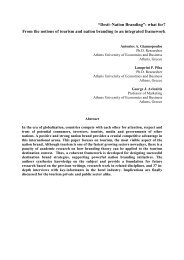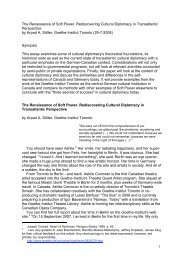Hable con ella - Institute for Cultural Diplomacy
Hable con ella - Institute for Cultural Diplomacy
Hable con ella - Institute for Cultural Diplomacy
You also want an ePaper? Increase the reach of your titles
YUMPU automatically turns print PDFs into web optimized ePapers that Google loves.
Pina Bausch in Pedro Almodóvar’s <strong>Hable</strong> <strong>con</strong> <strong>ella</strong> 433<br />
as a prominent element in Bausch’s depiction of gender relationships: the proximity of<br />
tenderness and aggression, <strong>for</strong> example, is demonstrated with smiling couples whose<br />
loving touches upon each other’s hair turns into hair pulling, or whose kisses turn into<br />
aggressive bites. Finally, there is Bausch’s ironic play with gravity: movement often is<br />
not directed upwards but rather downwards, <strong>for</strong> example when dancers after a lift let<br />
themselves fall towards the ground. Likewise, the vertical plane is complemented by the<br />
horizontal plane – an earmark of modern dance. However, Bausch’s dancers are not only<br />
lying or sitting on the ground. Enabled through props such as water and rubber mats, they<br />
are sliding on the floor, thereby breaking the limitations of dance with what appears to be<br />
children’s games or circus acts.<br />
Bausch’s code of movement reflects a larger question of sociopolitical <strong>con</strong>ditioning<br />
of norms and ideals of movements and behaviour over the course of the history of<br />
civilization. Academic classical dance technique emerged during the time of French absolutism,<br />
and, with its artificiality, codified stylization, and regimentation, it symbolizes<br />
the restraint and <strong>con</strong>trol of human affects and passions. By <strong>con</strong>trast, early twentiethcentury<br />
modern dance liberated the language of the body and its movements by seeking<br />
emotional expressiveness. Based on the different purpose and aesthetics of dance, the<br />
function of the body changed, <strong>for</strong> no longer was it the ideal of dance to defy gravity<br />
and no longer was the ultimate goal the physical encapsulation of <strong>con</strong>trolled emotions.<br />
Ausdruckstanz was the dance of expression epitomized by the works of expressionist<br />
choreographers such as Rudolf Laban, Oskar Schlemmer, Mary Wigman, and Kurt Jooss<br />
during the 1920s (cf. Manning and Benson 30–35). Jooss latter was a mentor of Bausch<br />
at the Folkwang school in Essen, and it is safe to say that she reexplored this tradition of<br />
Ausdruckstanz in the late sixties and the seventies (Cody 117).<br />
Critics have commented on Bausch’s use of the body’s discursive potential and suggested<br />
that her <strong>con</strong>cept is rooted in social practice, viewing the body as representation<br />
of gender, race, and class (Birringer 86). Raimund Hoghe compares the body in her<br />
theatre to a landscape – vulnerable, open, marked by experience – that narrates stories<br />
without words, that speaks from individual and common histories (“Für Pina Bausch”<br />
12). Fernandes underscores that the interdependence of the body and society must be recognized:<br />
“the personal body is a social body – a social <strong>con</strong>struction at psychological and<br />
physical levels, <strong>con</strong>stantly permeated and <strong>con</strong>trolled by repetitive discipline within social<br />
power relationships” (9). Anne Fleig has coined the apt term “Körper-Inszenierungen”<br />
to illustrate the function of the body as central medium to <strong>con</strong>vey critical meaning:<br />
“Körper-Inszenierungen veranschaulichen, modizifizieren oder hinterfragen zentrale<br />
gesellschaftliche Wahrnehmungs- und Deutungsmuster wie Natur/Kultur, Männlichkeit/<br />
Weiblichkeit oder Realität/Fiktion” (13). In other words, rather than celebrating a cult of<br />
physical artistry and mastery as in <strong>for</strong>malist detachment, Bausch seems primarily interested<br />
in “talking” about and questioning culturally <strong>con</strong>ditioned <strong>con</strong>structions of established<br />
dichotomies, such as nature-civilization, masculinity-femininity, reality-fiction, childhoodage.<br />
In addition to this, by exploring and subverting the expectations and rules of dance,<br />
she ironically and playfully comments on the medium of dance itself.<br />
Bausch’s work is said to have influenced the aesthetics of both European and<br />
American choreographers and theatre directors, <strong>for</strong> example Robert Wilson, Anne



